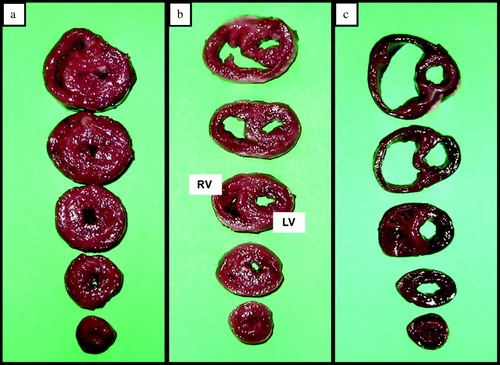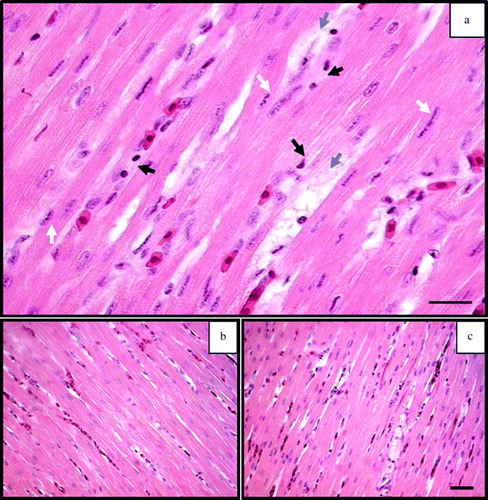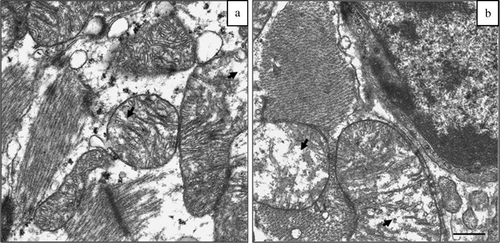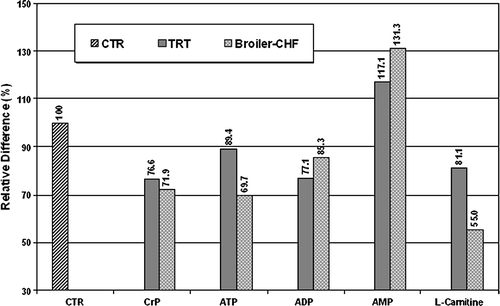Figures & data
Figure 1. Serial sections of broiler heart representing morphological changes characterized as (1a) mild ventricular dilation, (1b) moderate ventricular dilation, and (1c) severe ventricular dilation. RV, right ventricle; LV, left ventricle. It is noteworthy that as the dilation of the ventricular chambers increase, the thickness of ventricular myocardium decreases, which is indicative of degeneration of cardiac tissue.

Table 1. Incidence of CHF and SDS in broilers fed the diet spiked with MM extract (TRT) and those fed the placebo diet (CTR)
Table 2. Comparative study of CrP, ATP, ADP, AMP and l-carnitine content in the left ventricular myocardium in apparently normal broilers fed with placebo diet (CTR), in broilers fed the diet spiked with MM extract (TRT) and in broilers with CHF
Figure 2. 2a: Generic histo-pathological features of the mural left ventricular myocardium in a broiler indicative of a subclinical heart condition. Representative micrographs showing the extent of the lesions in (2b) broilers from the group fed the placebo diet and (2c) broilers fed the diet spiked with MM extract. Bars: 2a = 25 µm, 2b and 2c = 50 µm. In broilers with a subclinical heart condition (2a), typical lesions in the ventricular myocardium consisted of degenerative changes in the cardiomyocytes characterized by distinct dull darker pink appearance of affected cardiomyocytes with cytoplasmic eosinophilia and signs of chromatine condensation (white arrows). More advanced stages were evidenced by nuclear pyknosis and karyorrhexis (black arrows). Some cardiomyocytes showed vacuolated cytoplasm and degenerative changes in nuclei indicative of advanced changes (blue arrows). The lesions appear to have similar qualitative features in both groups, but in comparison with birds from the placebo group (2b), those fed the diet containing MM extract (2c) showed more extensive degenerative changes in the ventricular myocardium.

Figure 3. Representative transmission electron micrographs from the left myocardium of (3a) a broiler fed the placebo-containing diet and (3b) a broiler fed the diet containing MM extract. Bar = 1 µm. For the most part, myocardial mitochondria showed normal morphology with well-defined and dense cristae, but in some areas of the cardiomyocytes degenerative changes in the mitochondrial structure were evident. Examples of typical changes in mitochondrial morphology in broilers fed the placebo-containing diet (3a) and broilers fed the diet spiked with MM extract (3b). It is noteworthy that the changes in the mitochondria (arrows) such as swelling, vacuolization, and destruction of matrices and cristae were qualitatively evident in both groups, but are more severe in broilers fed the diet spiked with MM extract in comparison with broilers fed the placebo-containing diet.

Figure 4. Relative changes in cardiac CrP, ATP, ADP, AMP and l-Carnitine contents in broilers fed the diet spiked with MM extract (TRT), and in broilers with congestive heart failure (Broiler-CHF) as compared with broilers fed the placebo diet (CTR). Relative values for broilers fed the diet spiked with MM extract (TRT), and for Broiler-CHF are expressed on a percentage basis of data from CTR broilers representing on the graph a reference value of 100.
